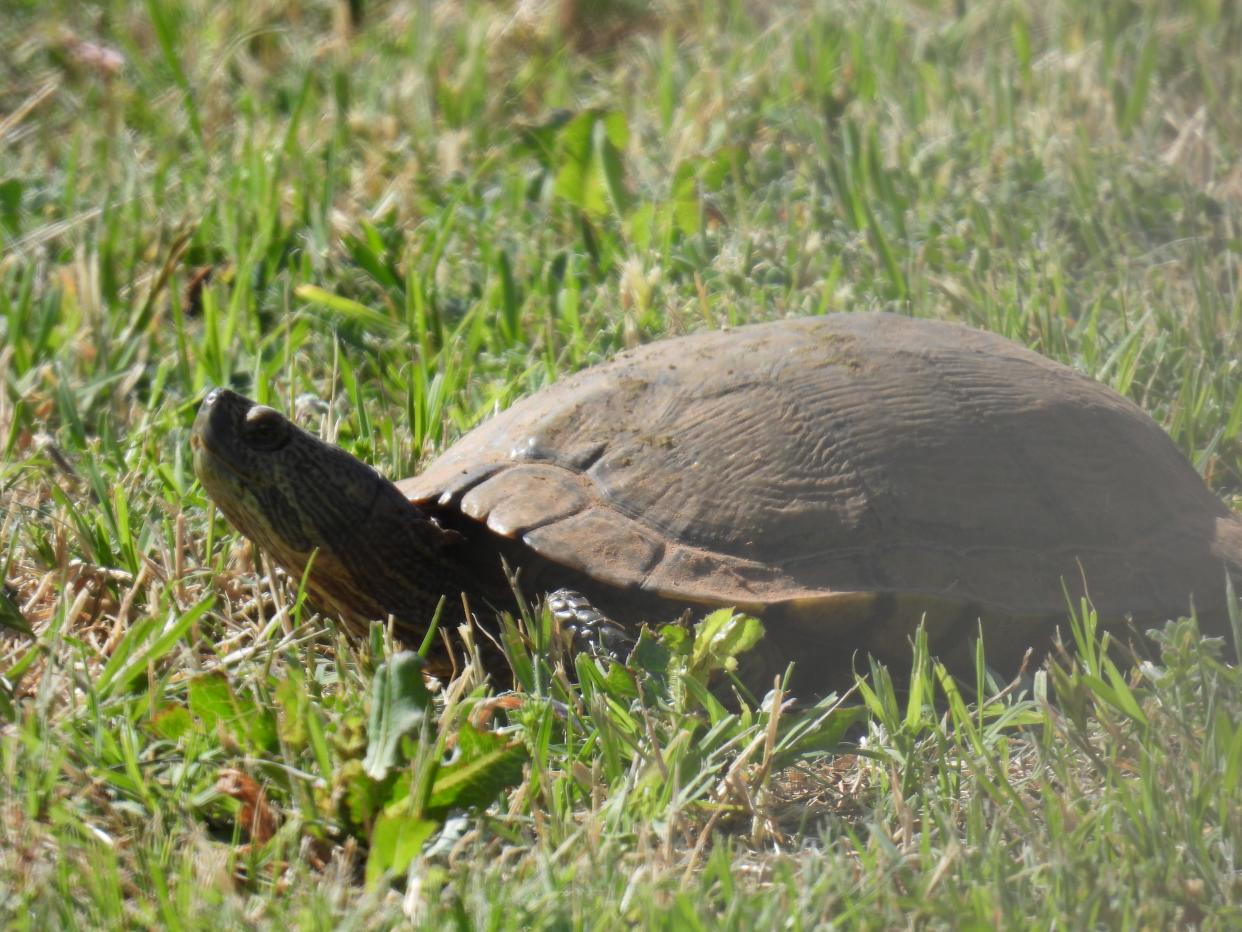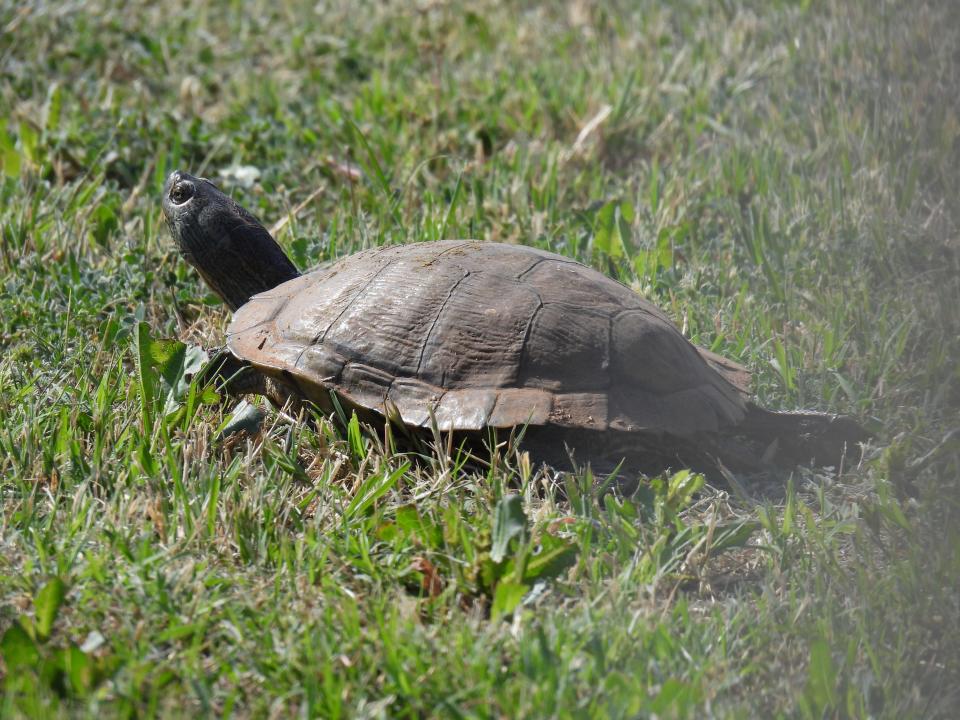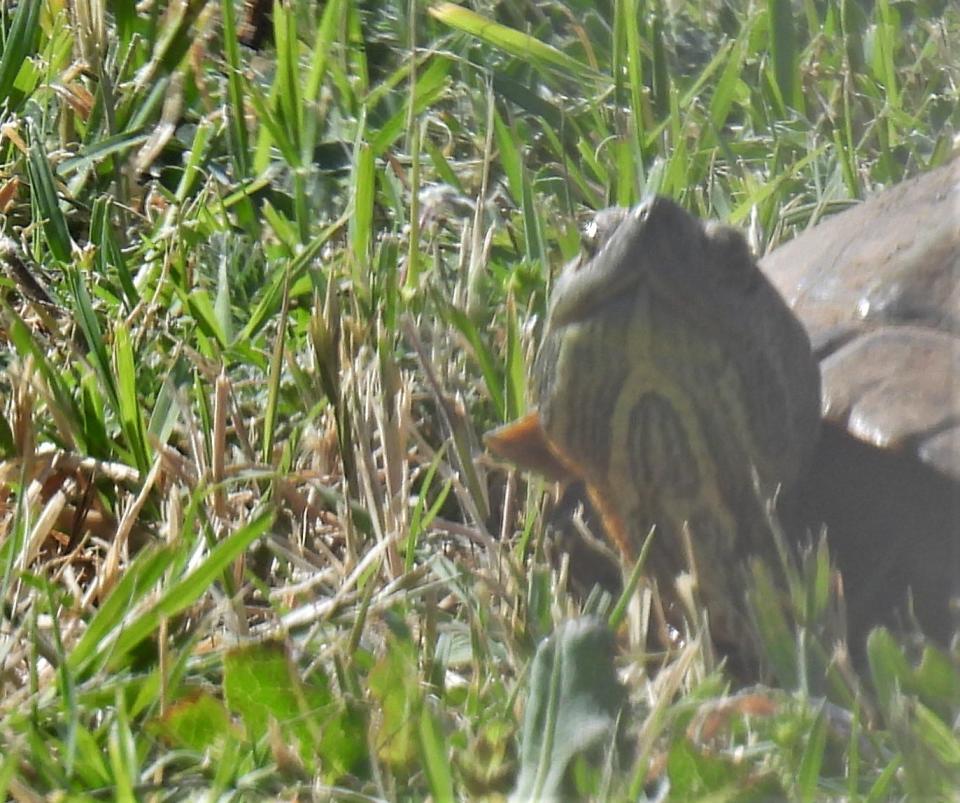Turtles: The aquatic ecosystem stewards

Turtles are often unfairly maligned as fish killers that ruin the ecosystems of our ponds, rivers, and streams. The facts are that many turtles are omnivores and consume large amounts of aquatic vegetation and carrion found in ponds and other bodies of water. Most turtle species actually help maintain healthy aquatic ecosystems by consuming dead and/or unhealthy fish or other animals and removing excess vegetation.
Cuter than a river cooter
At first glance, the River Cooter may be mistaken for the more abundant Red-eared Slider. However, the River Cooter lacks prominent red stripes behind the eyes and arrow-shaped, yellow markings found on the crown of Red-eared Sliders. Also, the shell of the River Cooter is noticeably pinched inward in front of the hind legs and some individuals may have light, ‘C-shaped’ markings on the carapace’s second costal scute. Their overall color is green with wide yellow stripes on the underside of the neck and thinner yellow stripes are found on the legs, tail, and top of the head. A characteristic marking is the yellow, central chin stripe which forks posteriorly to form a backward-facing ‘Y’ shape.

The River Cooters are diurnal and frequently seen basking on the edges of streams, ponds, and logs. Two clutches of approximately 20 eggs are produced each year and young turtles hatch from August through September. The River Cooter is protected from commercial trade and sale in Texas and Oklahoma.
Smooth and spiny softshells
Two less common local turtles are the Smooth and Spiny Softshell.
Adult Softshell Turtles can be large, approximately 21 inches, and have a flatter profile than other turtles. Their carapace is covered by leathery skin instead of bony scutes (although bone is present beneath the skin) and they have long, flexible necks and distinctive, elongated, tubular nostrils.
Spiny Softshell Turtles have small, conical projections on the anterior of the carapace and the male Spiny Softshell has light spots and/or dark ocelli (eye-shaped) patterns on the carapace. Both species have dark-bordered, light bands extending behind their eyes, and the Spiny Softshell has a second light band extending through the angle of its jaws.

Softshell turtles are rarely seen far from permanent bodies of water. The Smooth Softshell prefers rivers and streams with sandy bottoms; whereas, the Spiny Softshell occurs in a wider range of habitats.
The Smooth Softshell is found in the Red River and associated tributaries in our area; whereas, the Spiny Softshell is a resident of all major rivers and tributaries in the region. Both species are carnivorous, ambush predators and will bury themselves in mud or sandy bottoms in shallow water. Softshell turtles are more prone to biting if disturbed than many other species of turtles. Also, because of their long necks and flattened shapes, softshell turtles can flip themselves upright (if flipped onto their backs) more easily than other turtles! Softshell turtles can be commercially harvested in Texas for the pet trade and for meat.
It's a snapper!
The largest freshwater turtles in our area are Snapping Turtles which can get up to 40 pounds.
The Common (Eastern) Snapping Turtle is widespread around here whereas the larger Alligator Snapping Turtle is more often seen in eastern Texas and Oklahoma. Both have three lateral keels (ridges) on their carapace; but the keels are more prominent and noticeable on the Alligator Snapping Turtle. Because of their smaller shells, large heads, and long legs and tails, Snapping Turtles cannot retract inside their shells very well and are more likely to bite (or ‘snap’) when suddenly disturbed or threatened. However, despite fearsome reputations of being aggressive, Snapping Turtles are rather shy and usually go to great lengths to avoid humans and other threatening species/objects in their aquatic environments
The Alligator Snapping Turtle seems to prefer deeper waters; whereas, the Common Snapping Turtle may also be found in shallower, slower, more vegetated, and stagnant bodies of water. Both species rarely bask on land and forage primarily during nocturnal hours.
The Alligator Snapping Turtle has a pink, worm-like projection on its tongue which it uses as a lure while submerged to attract fish and other prey items. It eats mostly fish, but will also devour crayfish, snakes, birds, amphibians, small mammals and other turtles. Common Snapping Turtles are more omnivorous feeding on carrion and aquatic vegetation.
Snapping Turtles do not begin reproducing until approximately 10 years old; therefore, populations of these turtles increase (at best) at a slow rate! Populations of the Common Snapping Turtle appear to be stable; but the Alligator Snapping Turtle is a protected species in Texas and Oklahoma.
You’re more likely to see the River Cooter and Spiny Softshell turtles basking on land near water during appropriate weather. Approach them slowly and quietly and you may get a closer look before the turtles ‘escape’/dive into nearby waters! On the other hand, the much larger Common Snapping Turtle is rarely seen on land or at the water’s surface, and you may have to gaze down into the waters (if the water is clear enough) to sight one of these large, awesome, aquatic stewards.
Jim Goetze is a retired professor of biology and former chairperson of the Natural Sciences Department of Laredo College with an avid interest in all aspects of the natural world. He can be contacted at gonorthtxnature@gmail.com
This article originally appeared on Wichita Falls Times Record News: Turtles: The aquatic ecosystem stewards

